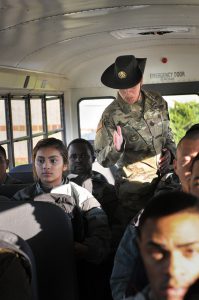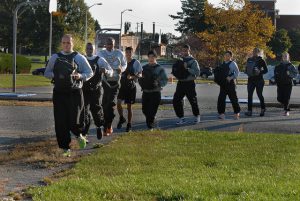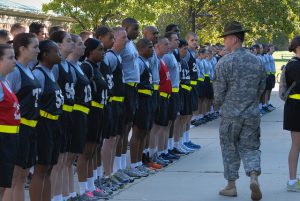Always Ready, Always There: MDNG implements positive changes for future soldiers
By Spc. Brianna Kearney, 29th Mobile Public Affairs Detachment—
EDGEWOOD, Md. – The changing times have caused a major increase in the amount of National Guard soldiers. The Army National Guard is the largest reserve component of the Army. States are working harder than ever to ensure that their recruits are ready for their commitments to the Guard. The Maryland Army National Guard’s Recruit Sustainment Program has evolved throughout the years and is ranked one of the top programs in the nation due to its adaption and evolution of its programs.
Master Sgt. Buddy Houston, senior operations noncommissioned officer of the Recruit Sustainment Program at the Edgewood Area of Aberdeen Proving Ground, Maryland, has been with the RSP since last October. His mission is to help evolve the RSP into a more streamlined program to improve the future warriors for their initial active duty training as well as provide their units with well-disciplined soldiers.

Within the RSP, groups these new enlistees are separated depending on their phase. Red Phase includes recruits who have not yet been to a drill weekend before. White Phase recruits have been to drill prior, and are more than 45 days away from their initial entry training starting date. Blue Phase recruits are 45 or fewer days away from shipping to Initial Entry Training. Gold Phase soldiers have already successfully completed IET and they are returning to prepare for the transition into their units as official Maryland National Guard soldiers. Each phase follows a different schedule, and one of the biggest challenges has been helping the recruits understand what to expect so they can thrive at basic combat training.
“We have integrated our Military Entrance Processing Station guidance counselors and our Gold Phase soldiers to paint a clear picture of what to expect, dispel Basic Combat Training myths and overcome concerns,” Houston said. “As a result of this collaborative effort, we successfully shipped 90 percent of [recruits].”

(Photo by Staff Sgt. Aimee Fujikawa, 29th Mobile Public Affairs Detachment)
The Maryland National Guard’s RSP has changed a great deal pertaining to their Gold Phase soldiers in order to better prepare them for an easier transition into their units. Their equipment is ordered and issued through the RSP, they are all briefed on their education benefits and the medical detachment brings in a team of doctors to update their records. The Gold Phase soldiers have a set standard before going out into their units, and the RSP ensures they are prepped and ready for whatever unit they are moving into.
An obstacle for some recruits was physical readiness. Some were not meeting the Army’s mandatory height, weight and physical fitness standards. The RSP created specific programs tailored to the needs of each warrior and were able to increase their individual level of fitness.
“We conduct an Army Physical Fitness Test every month for all our recruits to measure their physical readiness,” Houston said. “Those at-risk recruits participate in a Warrior Fit Program, led by Maj. John Fincatto, and his team of cross-fit certified NCOs, to teach these recruits how to improve their fitness.”

(Photo by Staff Sgt. Aimee Fujikawa, 29th Mobile Public Affairs Detachment)
The biggest difference between the MDARNG’s RSP and other states’ RSP is Grey Phase. This is an orientation that helps prior service enlisted, National Guard inter-state transfers or branch transfers, to become more familiar with serving in the Maryland Army National Guard. Grey Phase soldiers are issued their equipment prior to going to their assigned units and learn basic information to help smooth their transition into their units.
The changes implemented to the MDARNG’s RSP are proving to produce better, more qualified soldiers.
According to Maj. Latisha Lewis, RSP executive officer, the calculations stand at 89.7 percent in-training seat management which is the ability of the RSP to manage and properly ship recruits to training. Negative end strength is at 0.8 percent, that is recruits who have been to drill and consistently have not gotten paid. The program has a 97.3 percent shipper quality, the ability of the RSP to ship the recruits with minimal packet errors or deficiencies. Their ratings for these specific RSP metrics excel the average standards and earned them the rank of 36th out of 54 within the National Guard Bureau standings.
The matrix has improved from the following year, specifically, with improved advanced individual training graduation rates for the Maryland National Guard soldiers. The Maryland RSP ship rate is 90 percent compared to the national standard of 85 percent. The Maryland RSP believes they still have work to do to improve. The great efforts of the staff have impacted the RSP, and their evolution of positive change has just begun.
